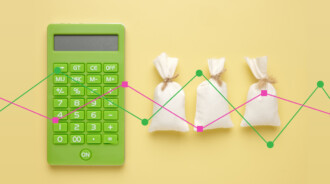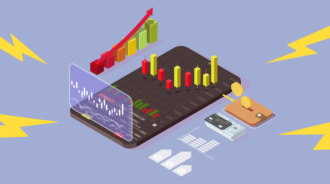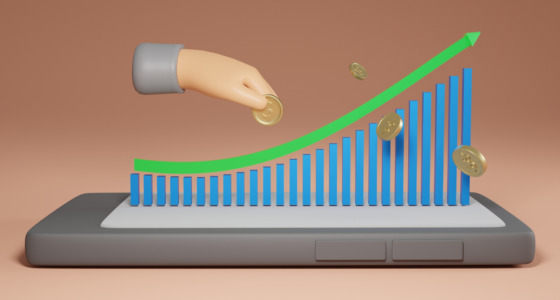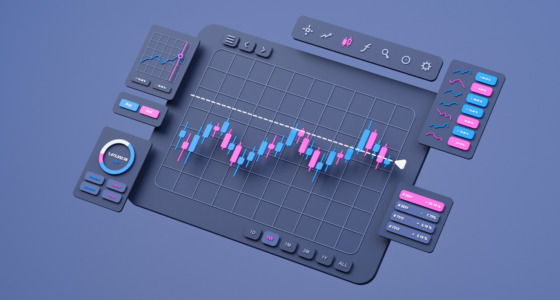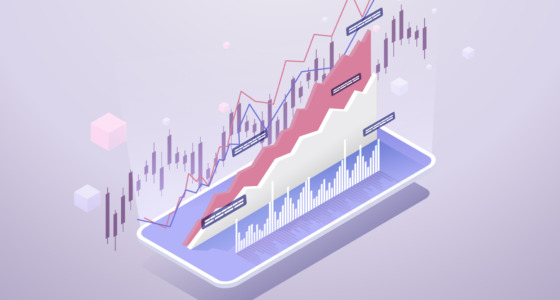

You often come across the term GDP when a country’s economy is discussed in newspapers, TV shows, governmental reports, and business sectors. GDP is an abbreviation that refers to gross domestic product, and it is a significant benchmark for analyzing countries’ economies globally.
In this article, we’ll explain gross domestic product meaning, approaches to understanding GDP, its types, methods of calculation, and limitations, and answer a few frequently asked questions.
What is Gross Domestic Product (GDP)?
Gross domestic product is the market value of finished products and services produced within a specific period (typically one year or a quarter) in a country. All of the output generated by a country contributes to its GDP.
GDP indicates whether the economy is rising by producing more goods and services or falling due to reduced output. Besides the services and products generated for sale in the market, GDP also counts some non-market production, such as healthcare services, public infrastructure, defense, and education services provided by the government.
It is important to note that all production activities are not included in GDP. For instance, volunteer work, unpaid work at home, and black market activities are excluded from GDP. To understand this, consider a parent who spends significant time and effort raising their children, providing them meals, education, and taking care of the home. Despite their contributions’ economic value, this non-market production activity performed within the house is unpaid and not included in GDP.
Approaches to Understanding GDP
Gross domestic product estimates use three basic approaches: production or output, expenditure, and income.
The Production or Output Approach
The production approach measures the “Value added” at each production stage. “Value added” can be defined as the total sales minus the value of intermediate inputs. For instance, an architect’s services are an intermediate input when constructing a home, and a fully built home is the final product. Similarly, when making pasta, all the ingredients are intermediate inputs, and the flavorful cooked pasta dish is the final product.
The Expenditure Approach
The expenditure approach sums the total value of purchases made by consumers or users, such as purchasing food items, housing items, vehicles, and investments in goods and services by businesses and governments.
The Income Approach
The income approach adds up the total income generated by production. For instance, revenue generated by businesses, wages and salaries earned by employees, interest, rental, and interest income.
Types of GDP
Gross domestic product or GDP can be represented in several ways.
Nominal GDP
Nominal GDP is a calculation of the total value of goods and services, considering the current prices over a specific period, typically 12 months. It displays the actual costs at which products and services are sold in the market during that particular time.
Nominal GDP does not consider inflation or deflation when adjusting for price fluctuations. For comparing the nominal gross domestic product of different countries, such as India or the United States, strictly financially, it is measured in either the native currency or U.S. dollars at market exchange rates.
Real GDP
Real GDP is more accurate at measuring a country’s economic health because it takes inflation and the overall increase in price levels. People are interested in knowing if an economy’s overall output of goods and services is expanding or contracting. However, since GDP is measured at nominal or current prices, comparing two periods without considering inflation is impossible.
The rate of increase in real GDP is frequently used to indicate the economy’s overall health. When real GDP multiplies, employment is expected to rise as businesses hire more workers for their factories and citizens, experience a boost in their financial resources. The fall in GDP leads to a decline in employment and other negative consequences.
Sometimes the gross domestic product may increase, but not quickly enough to produce sufficient employment for individuals looking for them. However, real GDP growth occurs in cycles across time. Economies experience booms and busts and periods of slow development or recession.
To calculate the ”Real GDP”, its nominal value needs to be adjusted by considering the price changes. The nominal value of GDP must be modified to account for price changes to obtain the “real” GDP. It will allow you to assess whether the output value has increased due to increased production or the prices have increased.
Real GDP is calculated using a GDP price deflator, which measures the price difference between the current and base years. For instance, if prices increased by 10% since the base year, the deflator would be 1.10. You can divide nominal GDP by this deflator to get real GDP. Because of positive inflation, nominal GDP usually exceeds real GDP.
GDP Per Capita
GDP per capita measures a country’s economic output per person. It estimates a country’s prosperity by measuring economic growth per inhabitant. The amount of money earned per person in a country is calculated as per capita income. This metric assesses the average per-person income for a particular region to determine living standards and overall quality of life. For instance, India’s gross domestic product per capita is 2600 USD as per IMF’s recent stats, which reflects the country’s average income by its population.
GDP per capita can be expressed as:
- Real;
- Nominal;
- Purchasing power parity.
If a country’s per-capita GDP grows without any population change, technological advancements allow higher economic outcomes with the same number of workers. Countries with small populations can sometimes have a higher per-capita GDP. This is because of the availability of many valuable resources, which help the existing population build a strong economy and have a high per-capita GDP.
Note! International Monetary Fund publishes global GDP data annually, showing GDP per capita by country.
GDP Purchasing Power Parity (PPP)
Purchasing power parity is the rate at which one currency is converted into another to buy the same quantity of products and services in each country.
It is not a direct measure of the gross domestic product; economists use purchasing power parity to determine how a country’s GDP compares to foreign currency (dollars). This approach accounts for local prices and living costs, thus enabling accurate cross-country comparisons of living standards and actual output.

GDP Formula
Three different approaches can calculate GDP; the expenditure approach, the outcome, and the income approach.
The Expenditure Approach
The expenditure approach is the most commonly used method for GDP calculation. In this approach, GDP is calculated by summing all its components, including consumption, investment, government spending, and difference in export and import profits.
The GDP formula is:
GDP = Consumption + Investment + Government Spending on Goods and Services + (Exports – Imports),
Which looks like this when written symbolically:
Y = C + I + G + (X-M),
where,
C = Consumption
I = Investment
G = Government spending
X = Export
M = Import
Here’s a brief description of all the terms included in the GDP equation:
- The Consumption (C) represents all private expenditures, including services, nondurables, and durables.
- Investments, denoted by I, refer to spending on housing and equipment.
- Government expenditures are denoted by G, including employee salaries, building roads, schools, and military spending.
- Exports are expressed as (X-M), the difference between imports and exports.
GDP vs. GNP vs. GNI
Although GDP is the most commonly used metric for expressing the economic growth of a country, some other matrices are also used.
GDP
- GDP stands for Gross Domestic Product.
- A nation’s gross domestic product (GDP) indicates the value of all finished products and services produced within its boundaries during a specific period, often a year.
- It emphasizes the geographical location of production and considers domestic and foreign-owned businesses operating within the country.
- GDP does not focus on the nationalities involved in the production; it only considers where the production occurs.
GNP
- GNP stands for Gross National Product.
- A nation’s gross national product (GNP) is an indicator of the value of all finished products and services produced by its residents (including individuals and businesses) regardless of their geographical location.
- It encompasses the output of businesses with both domestic and foreign ownership that are run by the nation’s citizens both inside and outside the country.
- GNP employs the production approach.
- The gross national product (GNP) includes the income of citizens of a country abroad and considers the nationality of the entities involved in the production.
GNI
- GNI stands for Gross National Income.
- GNI calculates the total income of residents of a country, whether it is earned internationally or domestically.
- It covers all earnings made by citizens of a nation as a result of their participation in production, including net income, profits, rents, and wages from abroad.
- GNI relies on the income approach.
- GNI excludes the income earned by non-residents within the country.
Summarizing it all, GDP calculates production within a country’s borders, GNP accounts for production by its citizens both domestically and internationally, and GNI includes all income received by its citizens from both domestic and foreign sources.
Which Indicator is More Appropriate or Preferable: GDP or GNI?
GNI has been proposed as a superior indicator of overall economic health than GDP in an increasingly globalized economy. The GDP of certain countries is significantly higher than the GNI because most of their revenue is withheld by foreign firms and people.
For instance, In Ireland, the impact of multinational firms causes GNI to differ significantly from GDP. Despite having a small local population, Ireland draws substantial foreign direct investment from global corporations. Due to the establishment of these firms’ regional or corporate headquarters, Ireland’s GDP is high. However, a significant portion of the revenue is sent back to the nations where the businesses are based. Therefore, Ireland’s GNI is lower than its GDP, reflecting the income transfer to foreign entities.
In contrast, there’s no significant difference in the GNI and gross domestic product of the United States. As of Q1-2023, the United States had a GDP of $26.49 trillion and a GNI of $23.62 trillion.
Adjustments to GDP
Several adjustments can be implemented to enhance the utility of a country’s GDP figure. According to analysts, a country’s GDP reflects the size of its economy but offers little insight into its standard of living. It is because the Inconsistency in population density and cost of living varies widely around the globe.
For instance, comparing the GDP of China and Switzerland won’t provide meaningful insights into the living conditions of the two countries because of the massive difference in the population size of both countries. According to recent estimates, China’s GDP per capita is 13,720 USD, while Switzerland’s is 98,770 USD.
Comparing the GDP per capita of the two countries, although the GDP per capita of Switzerland is higher than that of China, this figure doesn’t imply that a person in Switzerland is seven times better off than the average person in China. To understand the actual standard of living, various factors such as inflation rate, cost of living, and availability of different services and products at varying price levels must be considered.
The gross domestic product is expressed in the corresponding country’s currency. When comparing the output value in two countries with different currencies, you need to make adjustments. The typical approach is to first convert each nation’s GDP into U.S. dollars before comparing them. You can use market exchange rates or purchasing power parity exchange rates to convert the respective country’s currency into dollars.
When adjusted for PPP, real per-capita GDP is a highly accurate metric for determining real income, an essential element of well-being.
How to Use GDP Data?
Investors can use the gross domestic product as a valuable tool to guide them in decision-making. The GDP report’s business revenue and inventory statistics are beneficial to equity investors since they show overall growth. By comparing GDP growth rates across nations, investors can allocate their assets in businesses wisely.
The ratio of total market capitalization to GDP is another helpful tool for investors as it can provide insights into the valuation of an equity market. Likewise, to evaluate stock valuation, a common metric is the ratio between a company’s market capitalization and total sales (or revenues), or price-to-sales ratio per share.
Using the market capitalization ratio, you can measure the size of the stock market compared to the entire economy by dividing its total value by its GDP. This ratio can be applied to specific markets, such as the United States, or analyzed on a global scale. The indicator can help identify potential market trends and provide the level of investor optimism or pessimism.
How Does GDP Affect Me?
Gross domestic product has various indirect effects on your lives. Here are some critical elements of our lives that might get affected due to fluctuations in GDP.
Increase in Job Opportunities
A robust GDP growth frequently translates into a healthy job marketplace with greater employment opportunities. A higher GDP reflects more substantial economic activity, which could create more jobs in various fields.
Increase in Investment Opportunities
A rise in GDP leads to an increase in investment opportunities for individuals. Moreover, a strong GDP attracts domestic and foreign capital, resulting in corporate growth, innovation, and job creation.
Improved Living Standards
GDP growth can positively impact both income and living standards. Opportunities for salary growth, increased purchasing power, and access to a greater variety of goods and services may arise as the economy grows.
Improvement in Governmental Services
GDP is essential to the funding of government initiatives and services. A higher gross domestic product can provide more resources for investment in infrastructure, social welfare, education, and healthcare.
Economic Stability
An expanding GDP dramatically contributes to a country’s overall economic stability, providing financial security to its citizens. Besides that, it can maintain price stability, lessen inflationary pressures, and create a climate conducive to corporate success.
How to access Global GDP Data?
Various reliable databases can provide the latest information about the GDP of different countries:
- The Bureau of Economic Analysis in the U.S. Department of Commerce is an authentic direct source for data on the US GDP. You can see the newest publications of the bureau for the latest information.
- The World Bank also tracks and provides reliable GDP information, which can be accessed anytime.
- The Organization for Economic Cooperation and Development (OECD) also provides highly reliable GDP data. OECD data includes historical data as well as GDP growth forecasts. A limitation of this GDP database is that it only tracks OECD members and a few non-member countries.
- The International Monetary Fund (IMF) is an international financial organization that strives to advance international monetary cooperation and offers its member nations economic guidance and support. It provides GDP data through several databases, including the World Economic Outlook and International Financial Statistics.
Criticism and Limitations of GDP
Here are certain drawbacks to using GDP as an indicator and limitations which must be considered for a comprehensive analysis of a country’s prosperity.
Ignoring Unrecorded Economic Activities
GDP disregards unofficial and unreported economic activities like domestic production, unpaid volunteer work, underground markets, and undercover employment, which are critical in some countries and essential components of human life in all cultures.
Incomplete Representation of Development and Well-being
Gross domestic product growth alone cannot fully represent a country’s development or well-being because it may have a negative impact on the environment and income equality.
Income Distribution and Equity in GDP Measurements
The living standards depend on how GDP is distributed among the residents of a country instead of just the overall GDP levels. This feature emphasizes how crucial it is to focus on equity and income distribution in addition to GDP metrics.
Neglecting Business-to-Business Activity
The GDP’s emphasis on producing finished items and new capital investments ignores intermediate spending and business-to-business transactions. Compared to metrics that consider business-to-business activity, this overstresses consumption and decreases its sensitivity as an economic indicator.
Geographical Restrictions in a Global Economy
GDP ignores the profits earned by foreign investors that are remitted back to their native countries. It might exaggerate a nation’s accurate economic production.
Including Costs and Waste in GDP
Regardless of productivity or profitability, GDP counts all final private and public expenditures as income and output. As a result, damaging or inefficient activities are also included, such as wealth extraction, the manufacture of weaponry, and anti-crime spending.
The Bottom Line
The gross domestic product (GDP) is a crucial metric for assessing the strength and production of an economy. It serves as a measure of the total economic output of a country within its borders. GDP per capita offers a per-person indicator of economic development and standard of living.
However, using GDP as a comprehensive measure has some drawbacks. It fails to completely depict development and well-being, ignores unrecorded economic activity, and needs to account for income equity and distribution. The exclusion of business-to-business activities and geographical limitations in a global economy are other factors criticized about GDP. Despite these drawbacks, GDP remains a popular indicator for determining the state of the economy and making investment choices.
FAQs
GDP is a measurement that aims to capture a country’s output. Let’s look at what gross domestic product is in questions and answers.
What Is a Simple Gross Domestic Product Definition?
GDP is a metric measuring the value of all goods and services generated within a nation’s borders over a given period, typically a year. We can measure the size and health of an economy by estimating the monetary value of everything generated.
Which Country Has the Highest GDP?
According to the latest data from IMF (International Monetary Fund), Luxembourg is the highest GDP country, with a gross domestic product of 132,370 US dollars/per capita. Ireland is ranked as the second-highest country in GDP per capita rankings, with a value of 114,580 US dollars/capita. Norway holds the third rank with a GDP of 101,100 US dollars/per capita.
Is a High GDP Good?
A high GDP is good as it indicates that a country’s economy is strong and comes with other potential benefits, such as increased income and improved living standards. However, other factors, such as income distribution, environmental sustainability, and other social indicators for a precise evaluation of a country’s prosperity.
How does GDP Per Capita Differ from GDP?
GDP is the overall economic output of a country, while GDP per capita is specifically used to determine the financial outcome and prosperity per person.
How often is GDP data Updated?
The GDP data analysis depends on the country and organization; typically, it is updated quarterly or annually.

